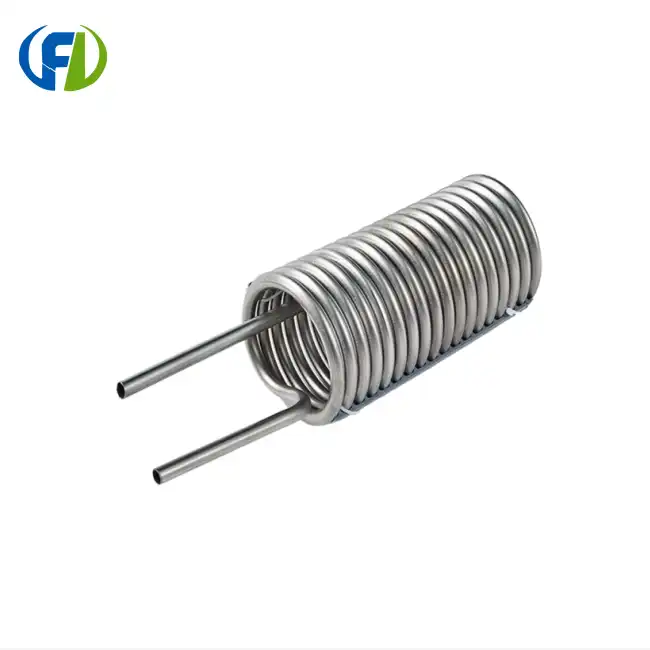Environmental Factors: Understanding SCC Mechanisms
To fully appreciate the potential of titanium rods in combating stress corrosion cracking, it's crucial to understand the environmental factors that contribute to this phenomenon. SCC occurs when a susceptible material is subjected to tensile stress in a corrosive environment. This triad of conditions - material susceptibility, stress, and corrosive medium - forms the foundation of SCC mechanisms.
Corrosive Environments
Various environments can promote SCC, including:
- Chloride-rich atmospheres (marine environments, industrial settings)
- High-temperature water systems
- Caustic solutions
- Hydrogen sulfide-containing environments (oil and gas industry)
The presence of specific ions, pH levels, and temperature all play crucial roles in initiating and propagating SCC. Titanium rods exhibit remarkable resistance to many of these corrosive environments, making them an attractive option for SCC prevention.
Stress Factors
Stress in materials can originate from various sources:
- Applied loads during operation
- Residual stresses from manufacturing processes
- Thermal cycling
- Welding-induced stresses
The ability of titanium to maintain its mechanical properties under stress, even in corrosive environments, contributes to its effectiveness in SCC prevention.
Material Susceptibility
Different materials exhibit varying degrees of susceptibility to SCC. Factors influencing susceptibility include:
- Alloy composition
- Microstructure
- Heat treatment
- Surface conditions
Titanium's unique metallurgical properties, including its ability to form a protective oxide layer, significantly reduce its susceptibility to SCC compared to many other materials.
Industry Case Studies: Successes
The effectiveness of titanium rods in combating stress corrosion cracking has been demonstrated across various industries. Let's explore some compelling case studies that highlight the success of titanium in challenging environments.
Aerospace Industry
In the aerospace sector, where material performance is critical, titanium rods have proven their worth:
- Aircraft structural components: Titanium rods used in critical load-bearing structures have shown exceptional resistance to SCC, even under the harsh conditions experienced during flight.
- Engine components: In high-temperature, high-stress environments, titanium rods have demonstrated superior performance compared to traditional materials, reducing incidents of SCC-related failures.
Chemical Processing Industry
The chemical industry, often dealing with aggressive environments, has benefited significantly from titanium's properties:
- Heat exchangers: Titanium rods used in heat exchanger tubes have shown remarkable resilience against SCC in chloride-rich environments, extending equipment lifespan and reducing maintenance costs.
- Reaction vessels: In processes involving corrosive chemicals, titanium components have exhibited excellent resistance to SCC, ensuring process integrity and safety.
Oil and Gas Industry
The challenging conditions in oil and gas extraction and processing have been met with titanium's robust properties:
- Offshore platforms: Titanium rods used in structural components and piping systems have shown exceptional resistance to SCC in marine environments, reducing the risk of catastrophic failures.
- Downhole tools: In high-pressure, high-temperature wells with corrosive fluids, titanium components have outperformed traditional materials in resisting SCC.
Desalination Plants
The desalination industry, dealing with highly corrosive seawater, has found a reliable ally in titanium:
- Pumps and valves: Titanium components in seawater handling systems have shown exceptional resistance to SCC, significantly extending equipment life and reducing maintenance requirements.
- Heat exchanger tubes: Titanium tubes have demonstrated superior performance in resisting SCC compared to other materials, ensuring long-term reliability in desalination plants.
These case studies underscore the versatility and effectiveness of titanium rods in mitigating SCC across diverse industrial applications. The success stories span from aerospace to chemical processing, oil and gas, and desalination, highlighting titanium's broad applicability in combating this pervasive issue.
Prevention Strategies: Design and Material Selection
While titanium rods offer significant advantages in preventing stress corrosion cracking, a comprehensive approach to SCC prevention involves careful design considerations and strategic material selection. Let's explore some key strategies for maximizing the effectiveness of titanium in SCC prevention.
Design Considerations
Effective design plays a crucial role in mitigating SCC risks:
- Stress reduction: Implementing design features that minimize stress concentrations, such as smooth transitions and generous radii, can significantly reduce SCC susceptibility.
- Cathodic protection: In some applications, incorporating cathodic protection systems can complement the inherent corrosion resistance of titanium, providing an additional layer of defense against SCC.
- Surface treatments: Techniques such as shot peening or laser peening can induce compressive surface stresses, enhancing titanium's resistance to SCC initiation.
- Welding considerations: Proper welding procedures and post-weld heat treatments can minimize residual stresses and maintain titanium's SCC resistance in welded structures.
Material Selection Strategies
Choosing the right titanium alloy is crucial for optimal SCC prevention:
- Grade selection: Different titanium grades offer varying levels of corrosion resistance and mechanical properties. For instance, Grade 7 titanium, with its palladium addition, offers enhanced resistance to reducing acids.
- Alloy customization: In some cases, custom titanium alloys can be developed to meet specific environmental and mechanical requirements, further enhancing SCC resistance.
- Composite solutions: In certain applications, titanium-based composites or hybrid structures combining titanium with other materials can provide optimized performance against SCC.
Maintenance and Monitoring
Even with titanium's excellent properties, ongoing maintenance and monitoring are essential:
- Regular inspections: Implementing routine non-destructive testing can help detect early signs of SCC, allowing for timely interventions.
- Environmental control: Where possible, controlling environmental factors such as temperature, pH, and chloride levels can further reduce SCC risks.
- Stress monitoring: Implementing stress monitoring systems in critical components can provide real-time data on stress levels, allowing for proactive maintenance.
Life Cycle Considerations
Taking a holistic view of the entire life cycle of titanium components is crucial:
- Initial cost vs. long-term benefits: While titanium may have a higher initial cost, its long-term benefits in terms of reduced maintenance, extended lifespan, and improved reliability often justify the investment.
- Recycling and sustainability: Titanium's excellent recyclability aligns with sustainability goals, offering environmental benefits over the component's lifecycle.
- Performance tracking: Implementing systems to track the long-term performance of titanium components can provide valuable data for future design and material selection decisions.
By integrating these prevention strategies with the inherent properties of titanium rods, industries can create robust solutions to combat stress corrosion cracking. The combination of thoughtful design, strategic material selection, and ongoing maintenance creates a powerful defense against SCC, leveraging the full potential of titanium in challenging environments.
Conclusion
As we've explored the world of stress corrosion cracking and the role of titanium rods in combating this pervasive issue, it's clear that these remarkable materials offer significant advantages across various industries. From their inherent corrosion resistance to their impressive mechanical properties, titanium rods have demonstrated their effectiveness in mitigating SCC in some of the most challenging environments.
However, it's important to remember that while titanium rods are a powerful tool in the fight against SCC, they are not a universal solution. The effectiveness of titanium in preventing SCC depends on a myriad of factors, including specific environmental conditions, stress levels, and application requirements. A comprehensive approach that combines the use of titanium with thoughtful design, strategic material selection, and ongoing maintenance is key to maximizing SCC prevention.
As industries continue to push the boundaries of material performance, the role of titanium in combating SCC is likely to grow. Ongoing research and development in titanium alloys and manufacturing processes promise even greater resistance to SCC in the future, opening up new possibilities for industrial applications.
In conclusion, while titanium rods may not be the singular, definitive answer to stress corrosion cracking, they undoubtedly represent a significant step forward in our ability to combat this challenging phenomenon. Their success across various industries demonstrates their versatility and effectiveness, making them an invaluable tool in the arsenal of engineers and manufacturers striving for improved reliability and performance in corrosive environments.
Are you looking for high-quality titanium rods for your SCC-prone applications? Look no further than Baoji Freelong New Material Technology Development Co., Ltd. Located in Baoji City, China's Titanium Valley, we specialize in the production and export of titanium, zirconium, nickel, niobium, tantalum, and other advanced alloys. Our commitment to quality and customer satisfaction has earned us the trust of clients across Australia, Korea, Germany, the US, UK, Malaysia, Middle East, Taiwan, and beyond. Let us help you find the perfect titanium solution for your needs. Contact us today at jenny@bjfreelong.com to learn more about our products and how we can support your SCC prevention strategies.
References
1. Jones, R. H. (2017). Stress-corrosion cracking: Materials performance and evaluation. ASM International.
2. Scully, J. R., & Gangloff, R. P. (2019). Stress Corrosion Cracking: Theory and Practice. Woodhead Publishing.
3. Leyens, C., & Peters, M. (2003). Titanium and titanium alloys: fundamentals and applications. John Wiley & Sons.
4. Schütze, M., Roche, M., & Bender, R. (2016). Corrosion resistance of steels, nickel alloys, and zinc in aqueous media. John Wiley & Sons.
5. Revie, R. W., & Uhlig, H. H. (2008). Corrosion and corrosion control: an introduction to corrosion science and engineering. John Wiley & Sons.
6. Craig, B. D., & Anderson, D. S. (1995). Handbook of corrosion data. ASM international.



_1764751890017.png)
_1745395351966.webp)
_1745746943725.webp)